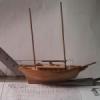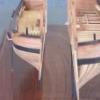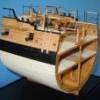-
Posts
2,305 -
Joined
-
Last visited
Reputation Activity
-
 NMBROOK got a reaction from cog in MORDAUNT 1681 by NMBROOK - Euromodel - 1:60 - Beyond Bashed
NMBROOK got a reaction from cog in MORDAUNT 1681 by NMBROOK - Euromodel - 1:60 - Beyond Bashed
Not a very exciting update today,however my experiment has been a success.I have been debating about caulking techniques and despite using a pencil for longer than I care to mention,it never looks as good as the black paper route.However after watching Dr Mike's dvd explaining that black paper prevents proper glue bond strength,himself using cheap white paper and dying it black,I wanted to find an alternative with a bit less faff Having to visit town today for other reasons I did stumble upon black tissue paper.I thought this would still allow proper penetration of the glue,but would it be easy to work with?I adopted worse case scenario for the test and cut some planks roughly(not even changing to a fine blade )on the table saw.Smearing one edge of these with alaphatic and placing them on the tissue edge on.Having left to dry for a hour(would really leave overnight in practice) and then cutting the tissue with a new scalpel blade close on the underside and a little above the face side,separated the planks.These were then glued to a sheet of ply.Two hours later this was scraped and sanded back.Again I would leave overnight but I was being deliberately rough for the trial.Anyway complete success.No issue with the tissue paper wanting to drag out of the joints as it was fully impregnated with glue and razor sharp black(not greyish you get with the pencil) lines.The only imperfections are from the rough edges of the planks.In reality these would be smooth .I wanted to crack this dilemma as this technique will be used on the whole build which includes the scarph joints in the keel and the hull planking so strength is important.A couple of pics but the difference between this and pencil isn't truly conveyed with my iphone camera.
Kind Regards
Nigel
-
 NMBROOK reacted to DocBlake in Blackening Britannia metal
NMBROOK reacted to DocBlake in Blackening Britannia metal
I wanted to avoid painting my Britannia metal fittings. Black paint on the guns just didn't look realistic. If I used Blacken-It, a dark crust would form, which rubbed off with a paper towel, leaving a barely darkened piece of metal. What to do?
I started by soaking the parts in a 50:50 solution of muriatic acid and water for 10 minutes. This cleaned and I think etched the surface a bit. Then into Blacken-it, full strength, for 10 minutes after rinsing. I polished the pieces with paper towel and Q tips, and while darker, they weren't where I wanted them. The last step was to soak the parts for 10 minutes in "Brass Black" Metal Finish by Birchwood Casey. After cleanup with paper towels and Q tips, almost no finish came off and the parts were a dark gunmetal color. Perfect! In certain lighting they almost have a faint bronze cast to them Here is a photo
Dave
-
 NMBROOK got a reaction from james c lusk in Simulated caulking
NMBROOK got a reaction from james c lusk in Simulated caulking
I think your point is a very valid one Chris,I think much is down to the modelers personal preference.I did consider no caulking on Mordaunt,the main reason I went ahead was my choice of timber.Boxwood is very monotone and if I applied no caulking the result would almost look like a solid block of wood.Regarding the museum models,the many photos I have relevant to English vessels of my prefered period,the correct hull planking is not even adhered to.Strakes of pear are used several planks wide and the treenailing is a true mechanical fixing that holds these strakes on.On some models the hull plank lines have been drawn on with pencil!
Kind Regards
Nigel
-
 NMBROOK got a reaction from Brian the extraordinaire in MORDAUNT 1681 by NMBROOK - Euromodel - 1:60 - Beyond Bashed
NMBROOK got a reaction from Brian the extraordinaire in MORDAUNT 1681 by NMBROOK - Euromodel - 1:60 - Beyond Bashed
Thank you very much indeed Nils for your very kind words ,I am pushing myself and pulling out all the stops on this one in the hope to create something a little bit special
Kind Regards
Nigel
-
 NMBROOK reacted to shoule in Simulated caulking
NMBROOK reacted to shoule in Simulated caulking
Ulises,
The prefab decking that I referred to is a process, I believe first incorporated as a manufacturing process, by a company called Teak Deckers, out of Sarasota, Fl. They go to a boat and make doorskin (1/8th luan ply wood) templates of the decks and ways and bring them back to the factory to make deck "panels". They leave the outside planks uncaulked, and the king and scallop planks out. When they bring the completed panels to the boat, they finish fit them, fit the king plank, and caulk the few panel seams and edges remaining. Two people can do in a day, what would normally take a week or more. The advantage, besides time, is less work or opertunities to damage something on the boat (the two are synonymous on boats), and an easy clean up without much dust. You can also make very fine listellos, and inlays in a more controled, ergonomic enviornment.
I've done them this way and the conventional way. The conventional way is fun, but prefab is cleaner, allows more artistic flexibility and, of course, is much easier on the back and knees. You also need less tools and room.
As far as what I did, Nigel seems to have put more thought into it, than I, to a fine result.
Below, is just a quick set up for some hatch planks, with perhaps too much glue in my hatse to answer your question, just to show you my crude method.
Once dry, I trim the paper up and draw a thin, sharp blade down through the laminated width edge and back along the plank to the end. It's really very little trouble and I'm surprisd that this is actually news to anyone.
The paper will take a dark color with most finish or stain that you put on it, in the end.
Regards,
Steve
-
 NMBROOK reacted to ChrisLBren in Simulated caulking
NMBROOK reacted to ChrisLBren in Simulated caulking
How about no caulking ? Most classic museum models do not depict it - this is more or less a recent addition in ship modeling.
Chris
-
 NMBROOK reacted to rtropp in MORDAUNT 1681 by NMBROOK - Euromodel - 1:60 - Beyond Bashed
NMBROOK reacted to rtropp in MORDAUNT 1681 by NMBROOK - Euromodel - 1:60 - Beyond Bashed
Nigel,
I appreciate your detailing the caulking. I used the same process but with a thin paper. (I have been experimenting with different papers to see how they looked.) Since I am gluing the planks and their paper caulking to a base, a piece of 1/64 birch ply, I figured that would be enough to overcome any bonding issues between the planks.
Originally I thought tissue paper would be too thin but after seeing your photos I will have to try it.
Also, I read the suggestion to clamp the planks together, then glue to the caulking paper. I was not sure how difficult it would then be to slit the paper without damaging the planks. I will have to try that also but with the tissue paper.
Nice work, I will be following since one of my kits on the shelf is the Falmouth, also by EuroModel.
Richard
Richard
-
 NMBROOK reacted to Mirabell61 in MORDAUNT 1681 by NMBROOK - Euromodel - 1:60 - Beyond Bashed
NMBROOK reacted to Mirabell61 in MORDAUNT 1681 by NMBROOK - Euromodel - 1:60 - Beyond Bashed
Looks great Nigel,
thae way you do the hull, the inovative caulking method and the whole build to date.... just amazing and a delight to follow. It is a real Special in scale 1/60, I trust this will at the end be a master Piece of model shipbuilding
Nils
-
 NMBROOK reacted to patrickmil in MORDAUNT 1681 by NMBROOK - Euromodel - 1:60 - Beyond Bashed
NMBROOK reacted to patrickmil in MORDAUNT 1681 by NMBROOK - Euromodel - 1:60 - Beyond Bashed
Nigel, what an excellent discovery! I have been using pencil, marker and black paper and all have their pros and cons, This looks like it is the best method. I will have to search for some black tissue paper as well. Great work on your ship so far.
-
 NMBROOK got a reaction from Bill Hime in MORDAUNT 1681 by NMBROOK - Euromodel - 1:60 - Beyond Bashed
NMBROOK got a reaction from Bill Hime in MORDAUNT 1681 by NMBROOK - Euromodel - 1:60 - Beyond Bashed
Not a very exciting update today,however my experiment has been a success.I have been debating about caulking techniques and despite using a pencil for longer than I care to mention,it never looks as good as the black paper route.However after watching Dr Mike's dvd explaining that black paper prevents proper glue bond strength,himself using cheap white paper and dying it black,I wanted to find an alternative with a bit less faff Having to visit town today for other reasons I did stumble upon black tissue paper.I thought this would still allow proper penetration of the glue,but would it be easy to work with?I adopted worse case scenario for the test and cut some planks roughly(not even changing to a fine blade )on the table saw.Smearing one edge of these with alaphatic and placing them on the tissue edge on.Having left to dry for a hour(would really leave overnight in practice) and then cutting the tissue with a new scalpel blade close on the underside and a little above the face side,separated the planks.These were then glued to a sheet of ply.Two hours later this was scraped and sanded back.Again I would leave overnight but I was being deliberately rough for the trial.Anyway complete success.No issue with the tissue paper wanting to drag out of the joints as it was fully impregnated with glue and razor sharp black(not greyish you get with the pencil) lines.The only imperfections are from the rough edges of the planks.In reality these would be smooth .I wanted to crack this dilemma as this technique will be used on the whole build which includes the scarph joints in the keel and the hull planking so strength is important.A couple of pics but the difference between this and pencil isn't truly conveyed with my iphone camera.
Kind Regards
Nigel
-
 NMBROOK got a reaction from Kevin in MORDAUNT 1681 by NMBROOK - Euromodel - 1:60 - Beyond Bashed
NMBROOK got a reaction from Kevin in MORDAUNT 1681 by NMBROOK - Euromodel - 1:60 - Beyond Bashed
Not a very exciting update today,however my experiment has been a success.I have been debating about caulking techniques and despite using a pencil for longer than I care to mention,it never looks as good as the black paper route.However after watching Dr Mike's dvd explaining that black paper prevents proper glue bond strength,himself using cheap white paper and dying it black,I wanted to find an alternative with a bit less faff Having to visit town today for other reasons I did stumble upon black tissue paper.I thought this would still allow proper penetration of the glue,but would it be easy to work with?I adopted worse case scenario for the test and cut some planks roughly(not even changing to a fine blade )on the table saw.Smearing one edge of these with alaphatic and placing them on the tissue edge on.Having left to dry for a hour(would really leave overnight in practice) and then cutting the tissue with a new scalpel blade close on the underside and a little above the face side,separated the planks.These were then glued to a sheet of ply.Two hours later this was scraped and sanded back.Again I would leave overnight but I was being deliberately rough for the trial.Anyway complete success.No issue with the tissue paper wanting to drag out of the joints as it was fully impregnated with glue and razor sharp black(not greyish you get with the pencil) lines.The only imperfections are from the rough edges of the planks.In reality these would be smooth .I wanted to crack this dilemma as this technique will be used on the whole build which includes the scarph joints in the keel and the hull planking so strength is important.A couple of pics but the difference between this and pencil isn't truly conveyed with my iphone camera.
Kind Regards
Nigel
-
 NMBROOK got a reaction from cog in MORDAUNT 1681 by NMBROOK - Euromodel - 1:60 - Beyond Bashed
NMBROOK got a reaction from cog in MORDAUNT 1681 by NMBROOK - Euromodel - 1:60 - Beyond Bashed
I have started to fit the upper hull starting from the stern forwards.By notching back the temporary stringers,I am able to use plain pear strip overwidth,rather than trying to develop individual shapes for each of the frame sections.There is a not very clear photo showing this.Each piece was fitted with an obechi infill individually.By using the digital vernier to check running dimensions as I went along,this avoided any accumulative build up of error.The obechi was thickness sanded(using a sanding block )to suit each location.There is variation in frame spacing due to working with the constraints of bulkhead positions,but it is so small,it unnoticable to the eye.I have set the obechi 2mm above the base of the upper trim(bottom of the ebony planking).This is to allow fine adjustment of the ends and then capping with 3mm boxwood.Doing it this way means no tool marks will be visible on the frames from shaping the ends of the obechi.This complete section has been trimmed 3mm below the cap rail so I can fit a square pear 'binding' stringer to tie everything together.I got this idea from Dr Mike and makes alot of sense to tie all these laminations together.It also provides a sanding guide for upper frame thickness.This will be pinned later into the top of some of the frames for additional strength.The length of this upper edge is overlong at present and steps down to a lower level,which will be cut back when the next section is complete.My technique just leaves a section to sand back when the temporary stringers are removed.I am considering replacing these afterwards,but bolting to the hull with M2 bolts as this area will be planked over.I am also considering using threaded rods as well to keep the upper hull the right distance apart as work progresses.
Kind Regards
Nigel
-
 NMBROOK got a reaction from ulrich in MORDAUNT 1681 by NMBROOK - Euromodel - 1:60 - Beyond Bashed
NMBROOK got a reaction from ulrich in MORDAUNT 1681 by NMBROOK - Euromodel - 1:60 - Beyond Bashed
Hi Chris
I think not only does it increase the glue area but also the rigidity.When I used to build on open bulkheads all the time,using kit 1.5mm first planking and the 1mm second,I used to find the hull flexed when sanding.You only have 2.5mm of material,take away the amount removed from sanding and in my opinion you are left with a very thin hull.As I mentioned earlier in the log,if the model gets exposed to increased humidity for any length of time then dries out again,this can result in the bulkheads 'ghosting through' in the finished profile.As I build models to outlive me many times over and if sold on have no control of the environment they reside in,I like to adopt a little extra 'insurance'.It is more work,but time is saved by not having to remove much material when sanding planking.Sovereign was double planked over a birch ply infilled hull,The two layers of planking over the top only needed the minimum amount of work to sand smooth.IMHO it is well worth the extra effort unless of course you are building a POF or model with many bulkheads where the planking is adequately supported.
Kind Regards
Nigel
-
 NMBROOK got a reaction from tarbrush in MORDAUNT 1681 by NMBROOK - Euromodel - 1:60 - Beyond Bashed
NMBROOK got a reaction from tarbrush in MORDAUNT 1681 by NMBROOK - Euromodel - 1:60 - Beyond Bashed
Hi Nils
The infill is my own addition.The kit is open bulkheads and double planking.I am using single planking of scale thicknesses due to the exposed framing on the upper hull.The planking will be spliced at the waterline,Ebony above and boxwood below.The bulkheads would not provide the necessary support for this procedure with single planking .I would have probably infilled anyway as it is my own preference but also there a many complex curves to this hull and to ensure everything is faired properly this is easier in the long run.
Kind Regards
Nigel
-
 NMBROOK got a reaction from Archi in MORDAUNT 1681 by NMBROOK - Euromodel - 1:60 - Beyond Bashed
NMBROOK got a reaction from Archi in MORDAUNT 1681 by NMBROOK - Euromodel - 1:60 - Beyond Bashed
Not a very exciting update today,however my experiment has been a success.I have been debating about caulking techniques and despite using a pencil for longer than I care to mention,it never looks as good as the black paper route.However after watching Dr Mike's dvd explaining that black paper prevents proper glue bond strength,himself using cheap white paper and dying it black,I wanted to find an alternative with a bit less faff Having to visit town today for other reasons I did stumble upon black tissue paper.I thought this would still allow proper penetration of the glue,but would it be easy to work with?I adopted worse case scenario for the test and cut some planks roughly(not even changing to a fine blade )on the table saw.Smearing one edge of these with alaphatic and placing them on the tissue edge on.Having left to dry for a hour(would really leave overnight in practice) and then cutting the tissue with a new scalpel blade close on the underside and a little above the face side,separated the planks.These were then glued to a sheet of ply.Two hours later this was scraped and sanded back.Again I would leave overnight but I was being deliberately rough for the trial.Anyway complete success.No issue with the tissue paper wanting to drag out of the joints as it was fully impregnated with glue and razor sharp black(not greyish you get with the pencil) lines.The only imperfections are from the rough edges of the planks.In reality these would be smooth .I wanted to crack this dilemma as this technique will be used on the whole build which includes the scarph joints in the keel and the hull planking so strength is important.A couple of pics but the difference between this and pencil isn't truly conveyed with my iphone camera.
Kind Regards
Nigel
-
 NMBROOK got a reaction from cog in MORDAUNT 1681 by NMBROOK - Euromodel - 1:60 - Beyond Bashed
NMBROOK got a reaction from cog in MORDAUNT 1681 by NMBROOK - Euromodel - 1:60 - Beyond Bashed
Work continues moving forward with the framing.When it came to sanding back the inside,unfortunately the 'binding' stringer that will be fitted at the top falls below the level of the temporary stringer on the outside.I measured the overall thickness including the outside temporary stringer on the thinned section on the stern using the verniers and used this dimension as my point of reference to sand down and profile the central section.Work now concentrates on completing the obechi infill.I have already started at the bow,this will need increasing in height at the sides as the hull edge flows down in an arc to meet the stem.
Kind Regards
Nigel
-
 NMBROOK got a reaction from CaptainSteve in Simulated caulking
NMBROOK got a reaction from CaptainSteve in Simulated caulking
My trial with black tissue paper has been a success.Using a similar technique to Steve,the tissue was glued to the plank edges first,trimmed back and then the planks laid in the normal way.The glue fully penetrated the tissue so there was no issue of it 'tearing out' when sanding.The glue penetration was an important issue for me as this will be used on the hull planking and keel scarph joints as well as the deck.Having used a pencil for many,many years,I do feel that this gives a superior look that is jet black without the greyish tinge you get from graphite.The picture doesn't really do it much justice and the planks were rough cut for the test(I didn't even put a fine blade in the table saw)
Kind Regards
Nigel
-
 NMBROOK got a reaction from janos in MORDAUNT 1681 by NMBROOK - Euromodel - 1:60 - Beyond Bashed
NMBROOK got a reaction from janos in MORDAUNT 1681 by NMBROOK - Euromodel - 1:60 - Beyond Bashed
Not a very exciting update today,however my experiment has been a success.I have been debating about caulking techniques and despite using a pencil for longer than I care to mention,it never looks as good as the black paper route.However after watching Dr Mike's dvd explaining that black paper prevents proper glue bond strength,himself using cheap white paper and dying it black,I wanted to find an alternative with a bit less faff Having to visit town today for other reasons I did stumble upon black tissue paper.I thought this would still allow proper penetration of the glue,but would it be easy to work with?I adopted worse case scenario for the test and cut some planks roughly(not even changing to a fine blade )on the table saw.Smearing one edge of these with alaphatic and placing them on the tissue edge on.Having left to dry for a hour(would really leave overnight in practice) and then cutting the tissue with a new scalpel blade close on the underside and a little above the face side,separated the planks.These were then glued to a sheet of ply.Two hours later this was scraped and sanded back.Again I would leave overnight but I was being deliberately rough for the trial.Anyway complete success.No issue with the tissue paper wanting to drag out of the joints as it was fully impregnated with glue and razor sharp black(not greyish you get with the pencil) lines.The only imperfections are from the rough edges of the planks.In reality these would be smooth .I wanted to crack this dilemma as this technique will be used on the whole build which includes the scarph joints in the keel and the hull planking so strength is important.A couple of pics but the difference between this and pencil isn't truly conveyed with my iphone camera.
Kind Regards
Nigel
-
 NMBROOK got a reaction from tarbrush in MORDAUNT 1681 by NMBROOK - Euromodel - 1:60 - Beyond Bashed
NMBROOK got a reaction from tarbrush in MORDAUNT 1681 by NMBROOK - Euromodel - 1:60 - Beyond Bashed
Work continues moving forward with the framing.When it came to sanding back the inside,unfortunately the 'binding' stringer that will be fitted at the top falls below the level of the temporary stringer on the outside.I measured the overall thickness including the outside temporary stringer on the thinned section on the stern using the verniers and used this dimension as my point of reference to sand down and profile the central section.Work now concentrates on completing the obechi infill.I have already started at the bow,this will need increasing in height at the sides as the hull edge flows down in an arc to meet the stem.
Kind Regards
Nigel
-
 NMBROOK got a reaction from NAZGÛL in MORDAUNT 1681 by NMBROOK - Euromodel - 1:60 - Beyond Bashed
NMBROOK got a reaction from NAZGÛL in MORDAUNT 1681 by NMBROOK - Euromodel - 1:60 - Beyond Bashed
Not a very exciting update today,however my experiment has been a success.I have been debating about caulking techniques and despite using a pencil for longer than I care to mention,it never looks as good as the black paper route.However after watching Dr Mike's dvd explaining that black paper prevents proper glue bond strength,himself using cheap white paper and dying it black,I wanted to find an alternative with a bit less faff Having to visit town today for other reasons I did stumble upon black tissue paper.I thought this would still allow proper penetration of the glue,but would it be easy to work with?I adopted worse case scenario for the test and cut some planks roughly(not even changing to a fine blade )on the table saw.Smearing one edge of these with alaphatic and placing them on the tissue edge on.Having left to dry for a hour(would really leave overnight in practice) and then cutting the tissue with a new scalpel blade close on the underside and a little above the face side,separated the planks.These were then glued to a sheet of ply.Two hours later this was scraped and sanded back.Again I would leave overnight but I was being deliberately rough for the trial.Anyway complete success.No issue with the tissue paper wanting to drag out of the joints as it was fully impregnated with glue and razor sharp black(not greyish you get with the pencil) lines.The only imperfections are from the rough edges of the planks.In reality these would be smooth .I wanted to crack this dilemma as this technique will be used on the whole build which includes the scarph joints in the keel and the hull planking so strength is important.A couple of pics but the difference between this and pencil isn't truly conveyed with my iphone camera.
Kind Regards
Nigel
-
 NMBROOK got a reaction from dgbot in Simulated caulking
NMBROOK got a reaction from dgbot in Simulated caulking
My trial with black tissue paper has been a success.Using a similar technique to Steve,the tissue was glued to the plank edges first,trimmed back and then the planks laid in the normal way.The glue fully penetrated the tissue so there was no issue of it 'tearing out' when sanding.The glue penetration was an important issue for me as this will be used on the hull planking and keel scarph joints as well as the deck.Having used a pencil for many,many years,I do feel that this gives a superior look that is jet black without the greyish tinge you get from graphite.The picture doesn't really do it much justice and the planks were rough cut for the test(I didn't even put a fine blade in the table saw)
Kind Regards
Nigel
-
 NMBROOK got a reaction from egkb in MORDAUNT 1681 by NMBROOK - Euromodel - 1:60 - Beyond Bashed
NMBROOK got a reaction from egkb in MORDAUNT 1681 by NMBROOK - Euromodel - 1:60 - Beyond Bashed
Not a very exciting update today,however my experiment has been a success.I have been debating about caulking techniques and despite using a pencil for longer than I care to mention,it never looks as good as the black paper route.However after watching Dr Mike's dvd explaining that black paper prevents proper glue bond strength,himself using cheap white paper and dying it black,I wanted to find an alternative with a bit less faff Having to visit town today for other reasons I did stumble upon black tissue paper.I thought this would still allow proper penetration of the glue,but would it be easy to work with?I adopted worse case scenario for the test and cut some planks roughly(not even changing to a fine blade )on the table saw.Smearing one edge of these with alaphatic and placing them on the tissue edge on.Having left to dry for a hour(would really leave overnight in practice) and then cutting the tissue with a new scalpel blade close on the underside and a little above the face side,separated the planks.These were then glued to a sheet of ply.Two hours later this was scraped and sanded back.Again I would leave overnight but I was being deliberately rough for the trial.Anyway complete success.No issue with the tissue paper wanting to drag out of the joints as it was fully impregnated with glue and razor sharp black(not greyish you get with the pencil) lines.The only imperfections are from the rough edges of the planks.In reality these would be smooth .I wanted to crack this dilemma as this technique will be used on the whole build which includes the scarph joints in the keel and the hull planking so strength is important.A couple of pics but the difference between this and pencil isn't truly conveyed with my iphone camera.
Kind Regards
Nigel
-
 NMBROOK reacted to mij in Simulated caulking
NMBROOK reacted to mij in Simulated caulking
I use a Chinagraph Pencil on one edge of the planks, as seen on the deck of my Xebec.
mij
-
 NMBROOK got a reaction from rtropp in MORDAUNT 1681 by NMBROOK - Euromodel - 1:60 - Beyond Bashed
NMBROOK got a reaction from rtropp in MORDAUNT 1681 by NMBROOK - Euromodel - 1:60 - Beyond Bashed
Not a very exciting update today,however my experiment has been a success.I have been debating about caulking techniques and despite using a pencil for longer than I care to mention,it never looks as good as the black paper route.However after watching Dr Mike's dvd explaining that black paper prevents proper glue bond strength,himself using cheap white paper and dying it black,I wanted to find an alternative with a bit less faff Having to visit town today for other reasons I did stumble upon black tissue paper.I thought this would still allow proper penetration of the glue,but would it be easy to work with?I adopted worse case scenario for the test and cut some planks roughly(not even changing to a fine blade )on the table saw.Smearing one edge of these with alaphatic and placing them on the tissue edge on.Having left to dry for a hour(would really leave overnight in practice) and then cutting the tissue with a new scalpel blade close on the underside and a little above the face side,separated the planks.These were then glued to a sheet of ply.Two hours later this was scraped and sanded back.Again I would leave overnight but I was being deliberately rough for the trial.Anyway complete success.No issue with the tissue paper wanting to drag out of the joints as it was fully impregnated with glue and razor sharp black(not greyish you get with the pencil) lines.The only imperfections are from the rough edges of the planks.In reality these would be smooth .I wanted to crack this dilemma as this technique will be used on the whole build which includes the scarph joints in the keel and the hull planking so strength is important.A couple of pics but the difference between this and pencil isn't truly conveyed with my iphone camera.
Kind Regards
Nigel
-
 NMBROOK got a reaction from dvm27 in Simulated caulking
NMBROOK got a reaction from dvm27 in Simulated caulking
My trial with black tissue paper has been a success.Using a similar technique to Steve,the tissue was glued to the plank edges first,trimmed back and then the planks laid in the normal way.The glue fully penetrated the tissue so there was no issue of it 'tearing out' when sanding.The glue penetration was an important issue for me as this will be used on the hull planking and keel scarph joints as well as the deck.Having used a pencil for many,many years,I do feel that this gives a superior look that is jet black without the greyish tinge you get from graphite.The picture doesn't really do it much justice and the planks were rough cut for the test(I didn't even put a fine blade in the table saw)
Kind Regards
Nigel












